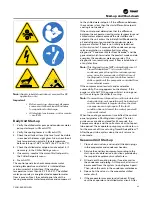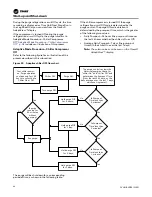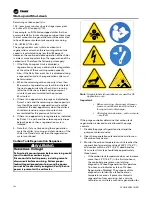
CVHH-SVX001G-EN
107
Table 26. Recommended maintenance (continued)
Daily
Every 3 months
Every 6 months
Annually
(a)
,
(b)
Use an ice water bath to verify the accuracy of the
evaporator refrigerant temperature sensor
(4BT11). If the sensor is exposed to temperature
extremes outside its normal operating range (0°F
to 90°F [-17.8°C to 32.2°C]), check its accuracy
at six-month intervals.
Inspect the condenser tubes for fouling; clean if
necessary.
Inspect and clean the ifm efector
®
flow detection
sensors. Use Scotch-Brite
®
or other non-abrasive
material to clean scale; do NOT use steel wool,
which could cause the probe to rust.
Submit a sample of the compressor oil to a Trane-
qualified laboratory for comprehensive analysis.
Measure the compressor motor winding
resistance to ground; a qualified service
technician should conduct this check to ensure
that the findings are properly interpreted. Contact
a qualified service organization to leak-test the
chiller; this procedure is especially important if
the system requires frequent purging.
(a)
Every three years, use a non-destructive tube test to inspect the condenser and evaporator tubes. It may be desirable to perform tube tests on these
components at more frequent intervals depending upon chiller application. This is especially true of critical process equipment.
(b)
Contact a qualified service organization to determine when to conduct a complete examination of the unit to discern the condition of the compressor and
internal components. Check the following: chronic air leaks (which can cause acidic conditions in the compressor oil and result in premature bearing wear)
and evaporator or condenser water tube leaks (water mixed with the compressor oil can result in bearing pitting, corrosion, or excessive wear).
Table 27.
Recommended maintenance of optional features
Feature
Every 3 months
Every 6 months
Annually
Waterbox Coatings
Inspect waterbox coatings within the
first 1–3 months to determine a
required maintenance schedule for your
job site. Refer to
Tubesheet Protective Coatings,” p. 109
for more information.
Waterbox Anodes
Inspect waterbox anodes within the first
1–3 months to determine a required
maintenance schedule for your job site.
Refer to
for
more information.
Gantries
Lubricate the gantries annually. Use ConocoPhillips
MegaPlex
®
XD3 (gray in color), LPS
®
MultiPlex Multi-
Purpose (blue in color), or equivalent.
Hinges
Lubricate the hinges annually. Use ConocoPhillips
MegaPlex
®
XD3 (gray in color), LPS
®
MultiPlex Multi-
Purpose (blue in color), or equivalent.
Recommended Compressor Oil
Change
After the first six months of accumulated operation or
after 1000 hours operation—whichever comes first—it
is recommended to change the oil filter. It is
recommended to subscribe to the Trane annual oil
analysis program rather than automatically change the
oil as part of scheduled maintenance. Change the oil
only if indicated by the oil analysis. Using an oil
analysis program will reduce the chiller’s overall
lifetime waste oil generation and minimize refrigerant
emissions. The analysis determines system moisture
content, acid level, and wear metal content of the oil,
and can be used as a diagnostic tool. Due to the new
refrigerant and oil combination, the oil analysis should
be performed by the Trane Chemical Laboratory.
In conjunction with other diagnostics performed by a
qualified service technician, oil analyses can provide
valuable information on the performance of the chiller
to help minimize operating and maintenance costs and
maximize its operating life. An access valve is installed
in the oil supply line, before the oil filter, for obtaining
oil samples.
N
No
otte
e:: Use only Trane OIL00022 compressor oil. A full
oil change is 21 gallons (79.5 L).
Purge System
Leak Checking Based on Purge Pump Out
Time
The following figure has been developed to aid in
determining when to do a leak check of a chiller based
on the purge pump-out time and unit size. This figure
Summary of Contents for CVHH CenTraVac
Page 126: ...126 CVHH SVX001G EN N No ot te es s ...
















































